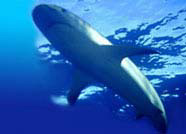


Sleeper shark

 |
 |
 |
|||
| Home | Evolution
| Classification
| Glossary | Biology
| Behavior | Shark
Repellent | Shark
Conservation | Do's &
Don'ts | Did You Know?
Sleeper shark |
 |
||||
|
 Scientific
Name: Somniosus microcephalus Scientific
Name: Somniosus microcephalusThe Sleeper shark, Somniosus microcephalus, is also called the Greenland shark and the gurry shark. This large, slow-swimming shark has glow-in-the-dark eyes. Sleeper sharks are large lethargic sharks, found year-round in cold polar waters. Despite their sluggish nature, they feed on last-moving prey and are one of only a few species known to catch and eat giant squid. Sleeper sharks are characterized by a bluntly round snout which is broad and flattened, round-tipped pectoral fins and no anal fin. They are medium-grey to blackish in color with no obvious lightened fin tips. Most sleeper sharks have luminous organs on their belly. These sharks commonly suffer from a copepod parasite that attaches to the cornea of the eye. It is not uncommon for a shark to have one of these parasites on each eye. The Greenland shark is up to 21 feet (6.5 m) long. This may even attract curious prey to the shark's head! The shark's upper teeth are long and sharp; the lower teeth are flatter, more closely set (and also sharp). It lives in very deep waters of the North Atlantic Ocean. It lives at depths down to 1,800 feet (550 m) in very cold water (36 to 45°F=2 to 7°C). These sharks swim to shallow Arctic waters (up to 80° North) during the winter to eat (they gather in large numbers to feed around fishing and sealing operations). They migrate back to deep waters during the summer. Eskimo hunters traditionally used this shark's skin for boots and its teeth for knives. They feed on a wide range of marine prey such as sea birds, fish, small cetaceans and molluscs. Giant and colossal squid beaks have been found in their stomachs, implying that they can catch and kill quite substantial prey. They may also scavenge on carcasses. Sleeper sharks are lethargic in nature, and they are easily caught. Despite of this, they are able to catch big preys at times. This large shark reproduces via aplacental viviparity, having litters of about 10 pups, each roughly 15 inches (38 cm) long. In aplacental viviparity, the eggs hatch and the babies develop inside the female's body but there is no placenta to nourish the pups. Sleeper shark's meat can be toxic unless prepared correctly. They are traditionally fished by Inuit people who use the skin for making boots and teeth for cutting hair. They are not thought to be endangered. Statistics: They can grow to a length of 3.6m (12ft) and weigh 320-365kg (700-800lb). Some species have reportedly reached over 7m (20ft). Sleeper Shark Classification:
|
|||||
| Sitemap | Reach To Us | Jimtrade - Business Directory of India | |||||